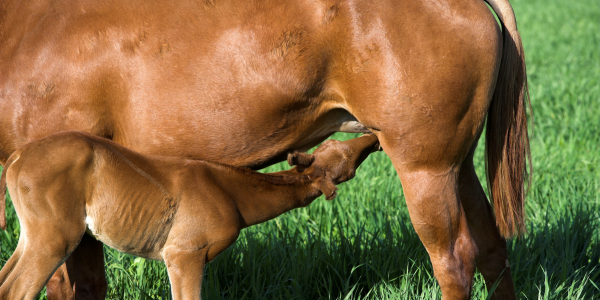Foaling
Breeding season is in full swing and the team have been busy seeing lots of beautiful mares and foals.
When it comes to the actual birth, the biggest difference between horses and other species, such as cattle, is the speed of foaling. Once stage 2 (active labour) has commenced, the foal should be born within 15-45 minutes. Foals ‘dive’ out of the mare with two front feet followed by the muzzle. You should call your vet within 10 minutes of active contractions beginning if the foaling isn’t progressing, or any issues are noted. There are a variety of options available to deliver the foal, from manually repositioning to a surgical caesarean section (which fortunately is incredibly uncommon).
Staging of foaling
Stage 1 – 1-4hrs – The mare is preparing for foaling, and starts to become restless, pawing, pacing and getting up and down. She may sweat up and frequently urinate and defecate.
Stage 2 – 15-45 minutes – This is active labour, when the mare’s waters break, contractions begin and the foal is delivered.
Stage 3 – 2-4 hrs following birth – Passing of the placenta
Two complications we see during foalings are red bag deliveries and retained foetal membranes (retained placenta). These are two conditions at the opposite ends of the spectrum involving the release of the placenta.
Red bag delivery
In a red bag delivery mares will deliver the foal within the placenta, rather than it bursting to release the foal. A red velvety bag is seen first, before the foal or any fluids. THIS IS AN EMERGENCY SITUATION as once the placenta has separated from the mare, the foal will not be receiving any oxygen. The foal requires immediate delivery. The ‘red’ bag needs to be broken open using your fingers or scissors. If both the foal’s feet and nostrils are present we recommend pulling to help the foal out quickly to give it the best chance of survival.
Retained placenta
A placenta is classed as ‘retained’ when it is still attached to the uterus (womb) 3–4 hours post-partum. At this point, veterinary advice should be sought as horses are very sensitive to toxins released from bacteria on a retained placenta. These toxins can then cause endotoxemia, colic and laminitis. As vets we usually give these mares a combination of antibiotics and anti-inflammatories, to reduce the risk of endotoxemia. We also administer drugs to stimulate the uterus to contract, flush the uterus, and finally apply gentle traction on the placenta. In some circumstances it can take several visits, and over 24 hours before the placenta has loosened sufficiently to be removed. The mare may require antibiotics and uterine flushing for several days thereafter.
Foal targets
- 1 hour – Standing
- 2 hours – Nursing
- 3 hours – Passed meconium (first droppings)
- 24 hours – Antibody (IgG) blood sample
Once the foal has been born, we expect them to stand and nurse within a couple of hours. This is particularly important as foals are born without antibodies which protect them from diseases in the environment. The mare’s colostrum contains antibodies, but the foal quickly loses the ability to absorb them. Maximum absorption occurs during the first 12 hours of life, with the foal’s gastrointestinal tract gradually losing the ability to absorb antibodies such that by 24 hours absorption has ceased.
We can check the foal has received sufficient antibodies with a blood test taken at the mare and foal’s 24-hour post-partum check. If the antibody levels are insufficient, we can administer hyperimmune plasma to boost the antibody levels to a protective level. This will protect the foal from life threatening conditions such as sepsis.
Planning on breeding your mare this year? Call us on 01772 861300 to request a FREE copy of our Mare & Foal Guide or to discuss the options available with one of our experienced vets.



